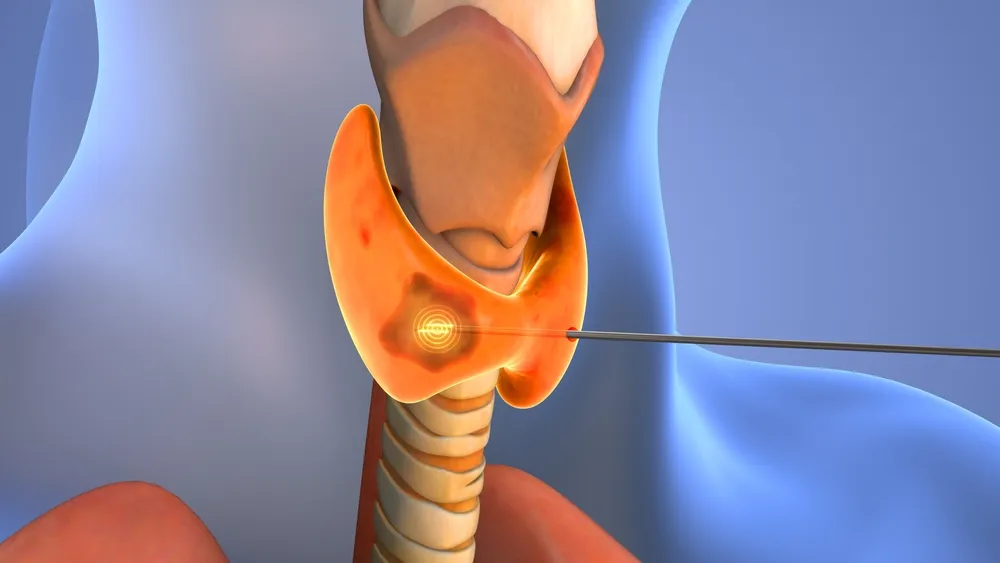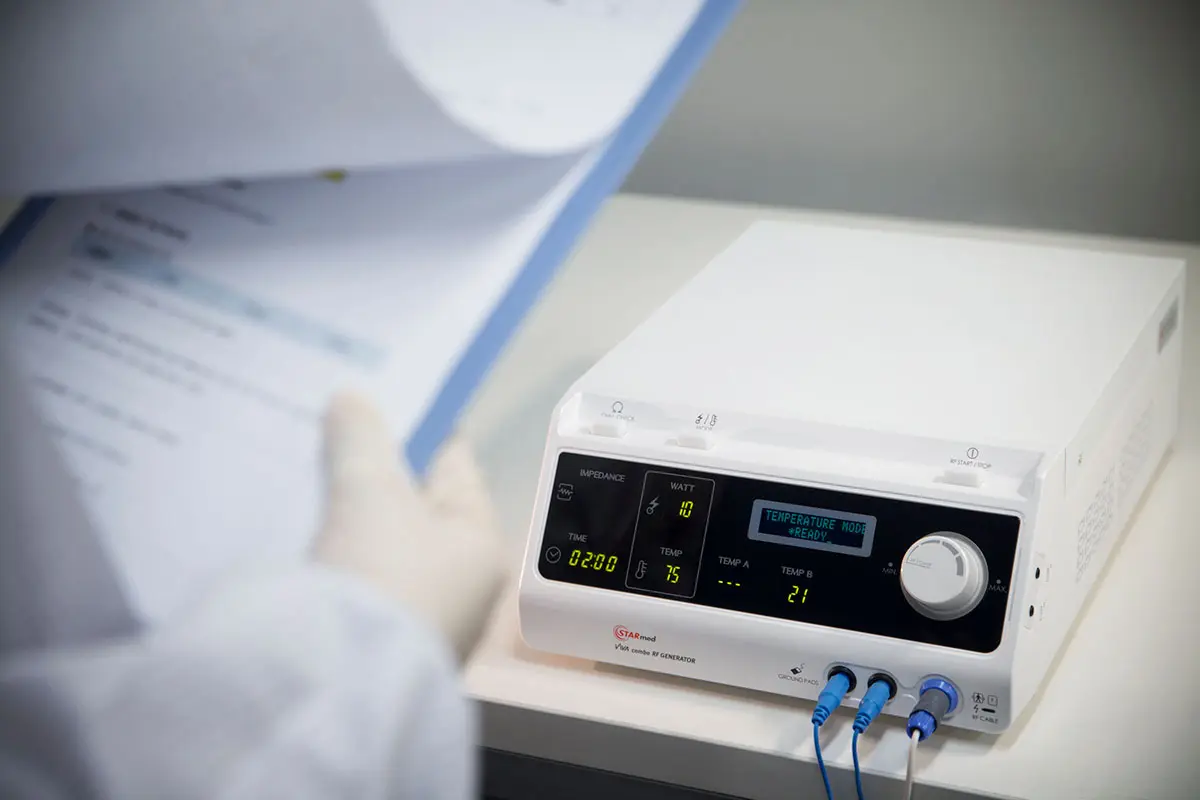Summary: Radiofrequency ablation (RFA) is a safe, effective, and minimally invasive treatment for thyroid nodules. Backed by over 160 clinical studies—including long-term results—RFA offers durable nodule reduction, symptom relief, and preservation of thyroid function.
- How does RFA work? Thermal energy targets and destroys thyroid nodules while sparing healthy tissue.
- RFA results: Nodules shrink 50–80% in 3–6 months, with continued reduction over time.
- Long-term efficacy: 90%+ reduction at 5–10 years; low recurrence rates.
- Symptom relief: Significant improvement in swallowing and cosmetic concerns.
- Safety profile: Low complication rates (1–3%), no general anesthesia required.
- Function preserved: Most patients retain normal thyroid function post-procedure.
- Minimally invasive: Outpatient, quick recovery, no visible scarring.
In recent years, RFA for thyroid nodules has emerged as a safe and effective treatment modality. It provides a minimally invasive, outpatient alternative to surgery.
To date, over 200 peer-reviewed studies have been published using STARmed’s RFA technology. This clinical evidence demonstrates significant nodule shrinkage and improved quality of life for patients. Many patients are surprised to learn just how long this technology has been in use across the globe.
One key to clinical success is communicating RFA’s efficacy to patients in a clear and effective manner. We’ve found it can be helpful to use data to support storytelling. In this guide, we’ll share meaningful evidence that reflects RFA’s positive clinical outcomes.
Continue reading to explore the latest evidence on RFA’s safety and efficacy for thyroid nodules.
How Does Radiofrequency Ablation Work?
Radiofrequency Ablation (RFA) treats thyroid nodules through the application of a high-frequency electrical current. A thin electrode probe is inserted into the thyroid nodule under ultrasound guidance. The goal is to generate heat and induce thermal destruction of the targeted tissue.
The RF generator emits an alternating current that causes ionic agitation and frictional heat in the tissue. This thermal ablation process ultimately raises temperatures in the nodule to ~60–100°C. The result is coagulative necrosis within the nodule. The targeted cells will then be resorbed by the body over subsequent weeks and months.
In other words, RFA selectively destroys thyroid lesions while sparing the majority of normal thyroid tissue.
The entire treatment usually lasts under an hour and is done outpatient. Throughout the procedure, the patient is awake, typically with local anesthetic and mild sedation. Vital structures are monitored before, during, and after the procedure to enhance safety.
RFA Results: Nodule Reduction and Symptom Relief
Clinical studies consistently report high nodule volume reduction rates (VRR) and significant symptom relief after RFA. Here is some of the most recent and notable clinical evidence regarding the overall efficacy of the procedure.
Rapid and Significant Volume Reduction
Within 3–6 months after RFA, thyroid nodules typically shrink by about 50–80% in volume. A multi-center North American study of 233 nodules found a median volume reduction of 73% at 6 months. It reached 76% at 12 months post-RFA.
Similarly, an international meta-analysis reported a pooled mean volume reduction of ~65% at 6 months. It increased to 77% at 12 months, with nodules continuing to shrink over time.
Durable Long-Term Efficacy
A recent 10-year study from Korea reported mean volume reductions of 81% at 2 years, 90% reduction at 5 years, and 94% reduction at 10 years. These findings were reported after a single RFA session.
Impressively, 18% of treated nodules in that study met criteria for complete “cure.” The study defined a cure as ≥90% volume reduction and no residual blood flow or symptoms.
Furthermore, only about 12% of nodules showed any significant regrowth over 10 years. Those nodes were often successfully managed with a repeat ablation.
Symptom and Cosmetic Improvement
Studies have documented significant drops in symptom and cosmetic scores after RFA. In one report, 70–90% nodule shrinkage at 5 years translated to corresponding improvement in swallowing and cosmetic concerns. Even at 10-year follow-up, patients maintained improved cosmetic and symptomatic outcomes after a single RFA treatment.
These RFA results demonstrate that radiofrequency ablation does work for appropriately selected thyroid nodules. Benign nodules consistently undergo measurable shrinkage with lasting symptom relief.
Safety Profile and Thyroid Function Preservation

One of the greatest advantages of RFA for thyroid nodules is its excellent safety profile. Patients and clinicians also appreciate the procedure’s ability to preserve normal thyroid tissue.
Here are some significant facts and clinical evidence reflecting the procedure’s safety profile and functional benefits.
Low Complication Rates
Large studies show that major complications from thyroid RFA are uncommon. They occur in only about 1–3% of patients overall. In the 10-year Korean study, the overall complication rate was 2.4%. Furthermore, there were no procedure-related life-threatening events or permanent complications reported.
Other minor side effects can include localized pain, mild neck swelling or bruising, or cystic fluid leakage. However, these minor complications are typically self-limited. Serious complications like lasting nerve injury are incredibly rare when standard safeguards are followed.
Thyroid Function Is Maintained
A key benefit of RFA is that it spares the majority of the thyroid gland. That eliminates the need for lifetime medications in nearly all cases.
A recent North American study emphasized that RFA preserves thyroid function while still achieving significant nodule reduction. This preservation of endocrine function is a major advantage for patient health and quality of life.
Minimally Invasive, Fast Recovery
As an outpatient procedure with only a needle puncture, RFA has a much quicker recovery compared to thyroidectomy. After a brief period of observation, patients typically go home the same day. Normal activities can often be resumed within 48 hours or sooner. There is rarely any surgical scar, and no need for hospital admission.
Technique and Training Matters
The consistently low complication rates reported in the literature are attributable to standardized technique and growing physician experience. Ongoing training programs like those supported by STARmed Academy are helping more clinicians become proficient in thyroid RFA.
Does Radiofrequency Ablation Work for Thyroid Nodules?
Does RFA work? The clinical evidence tells us that radiofrequency ablation is an effective treatment for thyroid nodules. Multiple high-quality studies have validated that RFA achieves substantial nodule shrinkage. Patients also experience symptomatic relief and low recurrence rates in benign nodules.
It is important for clinicians to understand that these outcomes are supported by authoritative clinical evidence. Interested in learning more? Look into our collection of clinical evidence for yourself. You’ll quickly discover why RFA for thyroid nodules is emerging as an integral treatment modality.





